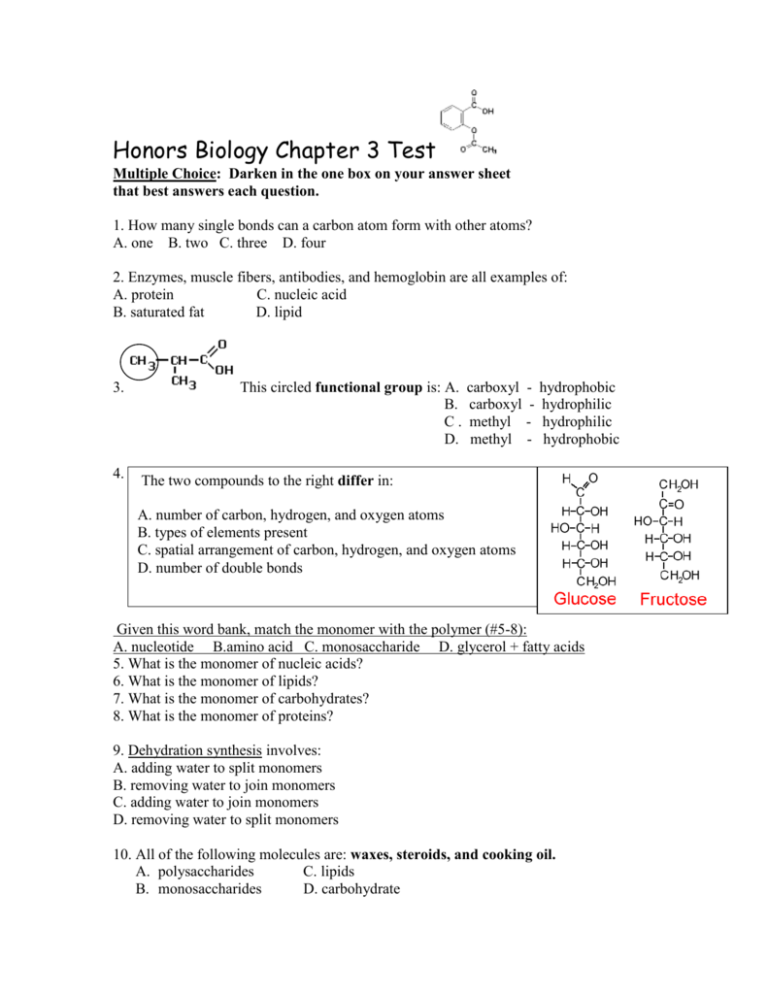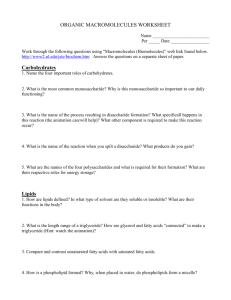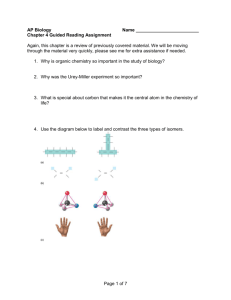Biology Chapter 3 Test
advertisement

Honors Biology Chapter 3 Test Multiple Choice: Darken in the one box on your answer sheet that best answers each question. 1. How many single bonds can a carbon atom form with other atoms? A. one B. two C. three D. four 2. Enzymes, muscle fibers, antibodies, and hemoglobin are all examples of: A. protein C. nucleic acid B. saturated fat D. lipid 3. 4. This circled functional group is: A. B. C. D. carboxyl carboxyl methyl methyl - hydrophobic hydrophilic hydrophilic hydrophobic The two compounds to the right differ in: A. number of carbon, hydrogen, and oxygen atoms B. types of elements present C. spatial arrangement of carbon, hydrogen, and oxygen atoms D. number of double bonds Given this word bank, match the monomer with the polymer (#5-8): A. nucleotide B.amino acid C. monosaccharide D. glycerol + fatty acids 5. What is the monomer of nucleic acids? 6. What is the monomer of lipids? 7. What is the monomer of carbohydrates? 8. What is the monomer of proteins? 9. Dehydration synthesis involves: A. adding water to split monomers B. removing water to join monomers C. adding water to join monomers D. removing water to split monomers 10. All of the following molecules are: waxes, steroids, and cooking oil. A. polysaccharides C. lipids B. monosaccharides D. carbohydrate Honors Biology Chapter 3 Test p. 2 11. The structure shown at the arrow to the right is a: A. peptide bond C. disulfide bond B. hydrogen bond D. glycosidic bond 12. If glycogen underwent complete hydrolysis, it would test: A. positive for proteins C. positive for starch B. positive for glucose D. positive for fats 13. The main function of cellulose is for: A. energy storage in plants C. fiber and cell wall support B. hormones in animals D. enzymes in animals 14. A single fatty acid chain is considered: A. ionic due to its oppositely charged ends B. amphipathic due to polar and non-polar ends C. hydrophobic due to its hydroxyl ends D. hydrophilic due to its carboxyl and hydroxyl ends 15. The R-group (side chain) of the amino acid aspartic acid is –COOH The R-group (side chain) of the amino acid leucine is –CH2-CH-(CH3)2. Where would you expect to find these amino acids in a globular protein in an aqueous (watery) solution? (HINT: where would the hydrophobic and hydrophilic functional groups point?) A. Aspartic acid would be in the interior and leucine would be on the exterior of the globular protein. B. Leucine would be in the interior and aspartic acid would be on the exterior of the globular protein. C. Both aspartic acid and leucine would be in the interior of the globular protein. D. Both aspartic acid and leucine would be on the exterior of the globular protein. 16. DNA and RNA are: A. nucleic acids B. proteins C. fats D. carbohydrates 17. How many different amino acids are there? A. 14 B. 20 C. 25 D. 28 18. “Denaturation” means to: A. unravel proteins + make them non-functional B. fold proteins into functional structural shapes C. split starch into its monomers D. form starch from its monomers H 2O protein Honors Biology Chapter 3 Test p. 3 19. Which is NOT the same as the other three? A. polypeptide B. amino acid chain C. protein 20. Galactose and maltose are: A. proteins B. carbohydrates C. lipids D. steroid D. nucleic acids 21. Ethanol, methanol, and pentanol would all contain the functional group: A. –NH2 B. –OH C. –SH D. -COOH 22. What are the names of the functional groups circled in the structural formula? A. amino and carbonyl C. hydroxyl and carboxyl B. amino and carboxyl D. hydroxyl and amino 22. 23. A triglyceride has: A. 2 glycerols + 1 fatty acid B. 3 glycerols + 3 fatty acids C. 1 glycerol + 3 fatty acids D. 2 glycerols + 3 fatty acids 24. Which of the following descriptions best fits the class of molecules known as nucleotides? A. a nitrogenous base, a phosphate group, and a pentose sugar B. a nitrogenous base and a phosphate group and a polysaccharide C. a nitrogenous base and a pentose sugar and a hydroxyl group D. a phosphate group and an adenine or uracil 25. C7H45O3 is a: A. protein B. lipid C. carbohydrate D. nucleic acid Refer to the diagram below, for questions #26-27: 26. At which bond would water need to be added to separate the dipeptide below? (Fill in A, B, C, D, or E on your answer sheet.) A. B. C. D. E. 27. The process above (adding water to split the dipeptide) is an example of: A. dehydration synthesis (reaction) of a protein B. hydrolysis of a protein C. dehydration synthesis of a carbohydrate D. hydrolysis of a carbohydrate Honors Biology Chapter 3 Test p. 4 28. Which of the following statements is NOT TRUE about saturated fats? A. They are more common in animals than in plants. B. They have multiple double bonds in the carbon chains of their fatty acids. C. They are generally solids at room temperature. D. They contain more hydrogen than unsaturated fats having the same number of carbons. Match the positive test results for the macromolecule it is used for: 31. A. starch B. lipid C. glucose D. protein 29. Iodine turning from straw yellow to blue-black. 30. Benedicts turning from blue to orange-red. 31. Brown paper (paper towel) showing a translucent (light can go through) spot. 32. Turns purple with Biuret’s solution. VOCABULARY MATCHING: Just continue in the multiple choice area. For #33-#36: Match the choices to the description in protein folding. A. Peptide bond C. hydrophobic interaction B. hydrogen bond D. disulfide bond 33. formed between –CH3 and –CH3 functional groups in the tertiary level 34. forms in the alpha helix and beta pleated sheets between –N-H and –C=0 groups 35. Holds together amino acids in the primary level. 36. Formed in tertiary folding between cysteine amino acids R-group. 37. The molecular formula for glucose is C6H12O6. What would be the molecular formula for a molecule made by linking four glucose molecules together by dehydration reactions? A. C18H36O18 C. C24H42O21 B. C18H32O16 D. C24H48O24 USE THE REFERENCE SHEET FOR QUESTIONS #38 – 49: 38. Which of the following is a polysaccharide? A. A B. I C. M D. F Honors Biology Chapter 3 Test p. 5 39. Which molecule is a polyunsaturated fatty acid? A. I B. B C. J D. K 40. Which molecule is(are) the amino acid(s) with a hydrophobic R group? A.H and M B. O and N C. only H D. H and N 41. Which molecule is a steroid? A. A B. B C.F D. G 42. Which molecule is glycerol? A. G B. B C. L D.D 43. Which structure is a phospholipid? A. F B. K C. C D. E 44. Which molecule is a disaccharide? A. A B. B C. F D. G 45. Which molecule is the structure for a purine? A. L B. N C. P D. O 46. Which molecule is a nucleotide? A. N B. P C. L D. D 47. Which is a triglyceride? A. J B. O C. C D. E 48. Which molecule would be responsible for making a lipid a liquid at room temperature? A. A B. I C. J D. K 49. Which amino acid has an ionic R group (acidic)? A. G B. H C. M D. O EXTENDED RESPONSE: 12 points 1. List the four levels of protein folding. 2. Draw and describe in a sentence the structure of the protein at each level. 3. On the drawings identify and label any bonding/ attraction that take place to make that shape. The first two levels require one type of bonding each, and the last two levels require at least two types of bonding. (List different types of bonding in the last two.)







